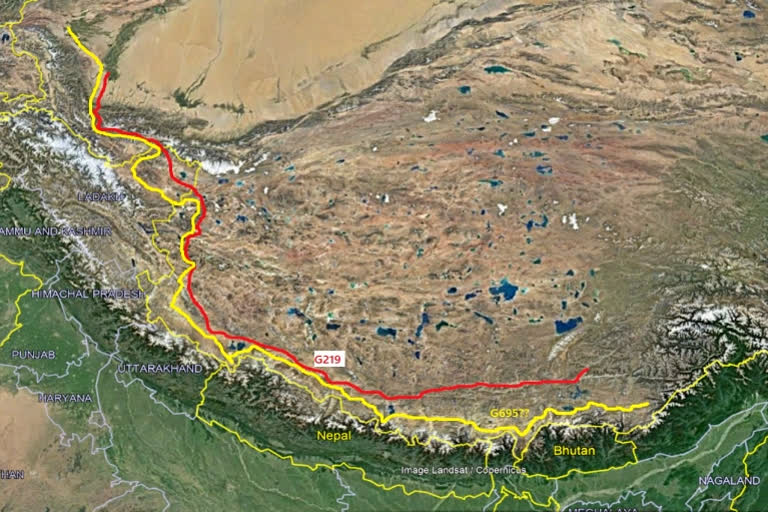Kibithu (near LAC, Arunachal Pradesh): In adherence to the revered 6th century BC master strategist Sun Tzu’s military strategy where the art of deception is a central tenet, China’s People’s Liberation Army (PLA), seems to have put it into practice in the Arunachal-China frontier in order to achieve tactical gains and pursue strategic aims.
While huge military structures have been erected just across Arunachal Pradesh in the border posts on the Chinese side of the blurry Line of Actual Control (LAC), there is not much sign of prolific human activity inside the compounds, leading to the conclusion that the well-built, often three-storey buildings may be an effort at deception.
Viewed with a binocular across Kibithu, one can see an imposing three-storey PLA building with bright colours as if to attract attention—quite unlike the non-descript and drab look of a military structure that tries to merge with the surroundings. The story is much the same in PLA border posts on the LAC.
Also read: Fighting ‘ghost’ villages on Arunachal-China border
A local government official posted at Kibithu, the last Indian border post in Arunachal’s Anjou district, told ETV Bharat on condition of anonymity: “Not only in the Chinese village of Sapchu across the Indian border across Kibithu, even in the other border outposts across the LAC in Arunachal Pradesh, not much human activity is seen. The building seems to be just a façade. Many people have observed this.”
The local government official’s version matches that of several official functionaries from the security establishment.
Infrastructure and Terrain
Another reason why PLA personnel are not deployed in adequate numbers in these border outposts, unlike India which maintains a robust presence, is that the road-heads are very near to the border outposts. So as and when there is a requirement, troops can be swiftly moved in to the forward posts. Therefore, all that is needed in the border outposts is ready infrastructure to support an adequate number of troops.
On the other hand, because of the terrain and developing infrastructure, the Indian establishment would have to expend a much bigger effort to transport men and material to the forward posts. In such circumstances, deploying men on the border or in proximate areas may be a better requisite.
Also read: On Arunachal-China frontier, it’s a 'War for Waves'
This would result in deploying Indian troops all across the LAC, which straddles some of the world’s toughest terrain in the Himalayas, resulting in a massive spreading out and stretching out of the Indian forces demanding logistics that will be a huge drain on the country’s finances.
Arunachal has five main river valleys—Kameng, Subansiri, Siang, Lohit and Tirap river valleys that lie in a north-south direction with deep gorges and fast-flowing rivers, making it a military challenge to connect easily in an east-west linkage.
On the other hand, China’s G219 and G695 highways run in parallel east-west directions almost all along the LAC. Reports say the still under construction G695 is located at an average distance of about 35 km north of the LAC while the G219—constructed more than 50 years ago is, on average, less than 200 km from the LAC. Access to the LAC from these highways is much easier than the Indian access to the LAC in Arunachal Pradesh.
Also read: With prowling UAVs, China, NE insurgents on hawk watch
While in eastern Ladakh, the PLA seems to have achieved the creation of buffer zones along the LAC, effectively fixating the un-demarcated border and blocking off Indian security personnel from patrolling areas that they had patrolled in the past, the Depsang and Demchok issues remain certain unresolved.
But on the whole, the PLA has drastically reduced the scope for border skirmishes and face-to-face encounters between patrolling parties of the two sides. In the central sector too, the PLA has kept sticking points alive over places like Barahoti in Uttarakhand's Chamoli district.
But the problem is most serious in the eastern sector across Sikkim and Arunachal Pradesh where the conscious PLA effort in 2017 to reach the Jampheri Ridge that overlooks the vulnerable Chicken’s Neck and the claim over Arunachal Pradesh as being part of “Southern Tibet” may be viewed as clear and present dangers that would be potential flashpoints in future with considerable maneuverable geo-political space for the PLA.
Ever since the current border conflict broke out in eastern Ladakh in April-May 2020, both the Indian army and the PLA have mobilized and deployed more than 1,00,000 soldiers along with war-like equipment along the LAC and in depth areas.


